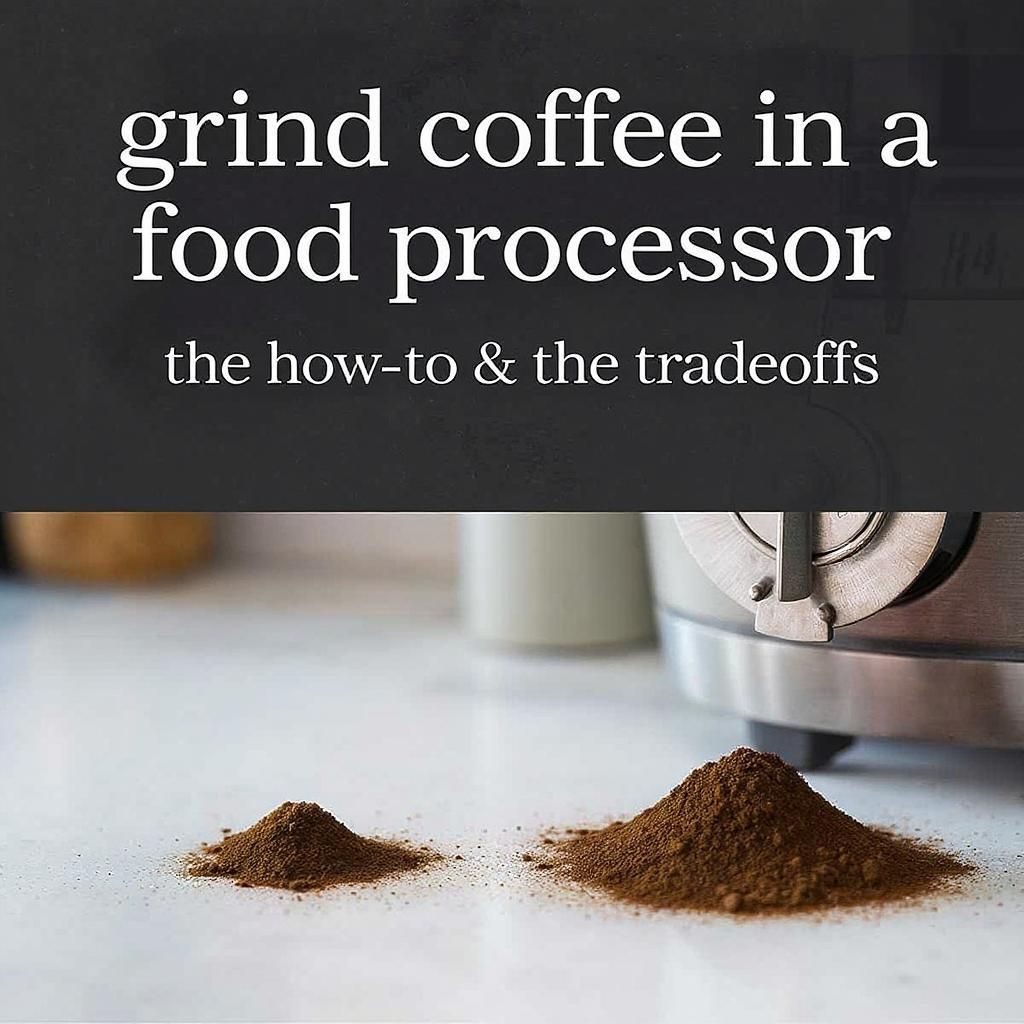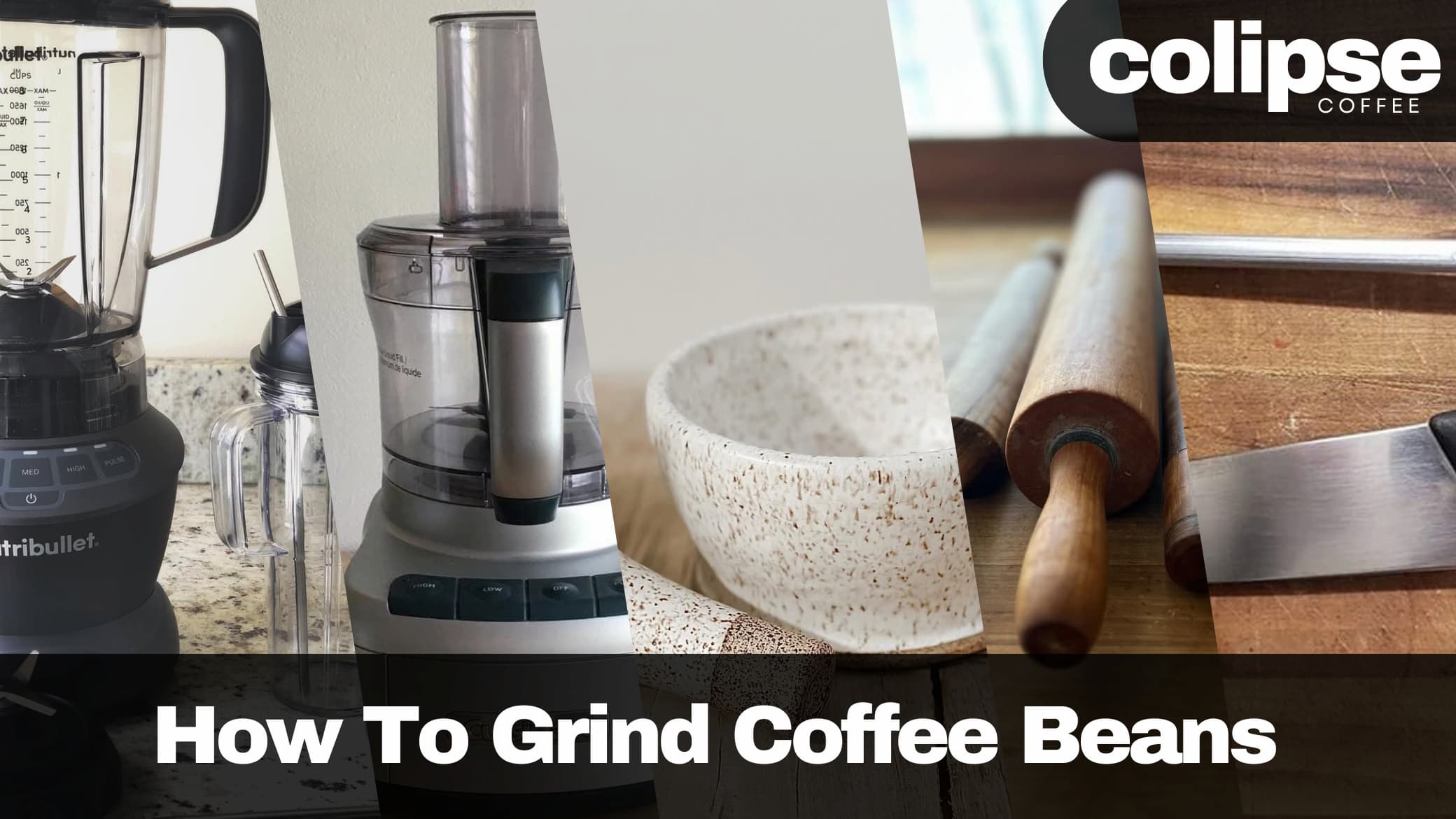As an Amazon Associate CoffeeXplore.com earns from qualifying purchases.
Grind Coffee in a Food Processor: The How-To & The Tradeoffs
You’re ready to brew a fresh, aromatic cup of coffee, but there’s one crucial problem: you have a bag of beautiful whole beans and no coffee grinder in sight. The food processor on your counter starts to look like a viable, if questionable, alternative. You’re left wondering if it will save your morning or ruin your expensive beans.
Yes, you can absolutely grind coffee beans in a food processor, but it is not the ideal method. It serves as a great emergency solution, but you should expect a highly inconsistent grind that can negatively impact the flavor of your final cup.
This guide will walk you through exactly how to get the job done when you’re in a pinch, leveraging extensive analysis of common methods and outcomes. We will cover the step-by-step process to minimize the drawbacks, explain the critical trade-offs you’re making, compare it to using a blender, and show you which brewing methods are forgiving enough to still produce a decent cup.
The Short Answer: Can You Grind Coffee Beans in a Food Processor?
Yes, you can grind coffee beans in a food processor, but it is not ideal. It works in a pinch, but be prepared for an inconsistent grind and potential flavor issues.
So you have whole beans, a food processor, but no coffee grinder? Let’s get you that cup of coffee. The simple truth is that a food processor will break down whole coffee beans into smaller grounds. However, the machine is designed for chopping, not pulverizing. This fundamental difference is the source of all the problems you might encounter.
The key takeaway is this: Using a food processor is a compromise. You trade grind quality and flavor potential for the convenience of using an appliance you already own. It’s a temporary fix, not a permanent replacement for a proper coffee grinder.
How to Grind Coffee Beans in a Food Processor: A Step-by-Step Guide
To grind coffee in a food processor, use the pulse setting in short bursts, work in small batches, and stop when the grounds reach your desired (though likely inconsistent) size. Following these steps carefully is crucial to mitigate the two biggest risks: generating too much heat and creating an unusable mix of dust and boulders.

Here is the best way to approach it for a drinkable result.
Step 1: Prepare Your Food Processor and Beans
Before you even think about adding the beans, proper preparation is essential to avoid contaminating your coffee’s flavor. Coffee oils are potent and can be absorbed by the plastic bowl of a food processor, especially if it’s not perfectly clean.
- Cleanliness is Critical: Your food processor bowl, lid, and blade must be completely clean and dry. Any lingering food residue, especially from pungent ingredients like garlic or onion, will ruin your coffee.
- Work in Small Batches: Do not fill the food processor. Grind only enough coffee for the brew you are about to make, typically about 1/2 to 1 cup of beans at a time. This allows the beans to move more freely and results in a slightly more even grind.
- Check for Odors: Pro Tip: Smell the food processor bowl before you start. If it smells like last night’s onions, give it another wash! Any stored odors will transfer directly to your coffee grounds.
Step 2: Use the “Pulse” Setting in Short Bursts
This is the single most important technique. Running the food processor continuously will generate significant heat from the friction and the motor, effectively “cooking” your beans before you brew them. This releases delicate oils too early and creates a burnt, bitter taste.
Think of it like a controlled demolition, not a free-for-all. You’re in charge of the texture.
- Secure the lid and use the ‘pulse’ button to run the blade for only 2-3 seconds.
- Stop and allow the beans and grounds to settle. You can even give the processor a little shake to redistribute the larger pieces.
- Repeat this process of pulsing for a few seconds and then stopping. Continue until you reach a texture that looks mostly uniform, which might take 10-20 pulses depending on your machine.
Step 3: Assess the Grind and Know When to Stop
Perfection is not the goal here; “good enough” is. Because a food processor chops instead of grinds, you will never achieve the uniform consistency of a burr grinder. You will inevitably have a mix of fine powder and larger chunks.
- Aim for Coarse: Your best bet is to aim for a coarse, sandy texture, similar to what you’d use for a French press. Trying to get a fine, espresso-like grind will only result in more heat and a larger proportion of dust.
- Visual Cues: Look at the overall texture. When most of the beans have been broken down and you see fewer large, visible pieces, it’s time to stop.
- Accept Inconsistency: You will see some very fine powder mixed in with coarser bits. This is the nature of the method. Over-processing to eliminate the big chunks will only create more ultra-fine dust, which leads to over-extraction and bitterness.

Don’t chase perfection here. Aim for ‘good enough for a French press’ and you’ll be much happier!
The Tradeoffs: Why a Food Processor Isn’t a Grinder
While it works in an emergency, it’s crucial to understand why, as many coffee pros will tell you, a food processor is a poor substitute for a dedicated coffee grinder. The issues stem from its fundamental design and impact the most important part of your coffee: the taste.
| Drawback | Impact on Your Coffee |
|---|---|
| Inconsistent Grind Size | The blades chop beans randomly, creating a mix of fine dust and large chunks. The dust over-extracts, making the coffee bitter and muddy. The chunks under-extract, leading to a sour, weak flavor. The final cup is unbalanced and lacks clarity. |
| Heat Generation | The high speed of the blades and motor creates friction, heating the grounds. This “pre-cooks” the beans, stripping them of their delicate aromatic oils and resulting in a flat, burnt, or stale taste. |
| Oil Absorption in Plastic | Most food processor bowls are plastic. Coffee beans release oils during grinding, which can be absorbed by the plastic. These oils quickly go rancid, imparting a foul taste to your coffee and any other food you later prepare in the processor. |
| Lack of Control | Unlike a burr grinder with adjustable settings, a food processor offers no real control over the final particle size. Your only variable is time, which is an imprecise way to manage a grind that needs to be consistent down to the micron level. |
Food Processor vs. Blender for Grinding Coffee: Which is Better?
If you’re without a grinder, you might also be eyeing your blender. So, which is the lesser of two evils? A food processor is slightly better than a blender for grinding coffee because its wider, flatter bowl allows for a marginally more even grind than a blender’s tall, conical shape.
Ever tried to get that last bit of smoothie out of the bottom of your blender? That’s the same problem coffee grounds have. The vortex created in a blender pulls material down into the blades, but the conical shape makes it difficult for all the beans to be chopped evenly. A food processor’s shape is more forgiving.
| Feature | Food Processor | Blender |
|---|---|---|
| Bowl/Container Shape | Wide and flat, allowing beans to spread out and be hit by the blades more evenly. | Tall and conical, causing beans to get stuck at the bottom or flung to the sides, leading to a very uneven grind. |
| Grind Consistency | Poor and inconsistent, but generally better than a blender. | Very poor and extremely inconsistent. Often results in whole beans being left untouched while others are pulverized into dust. |
| Verdict | Slightly better choice. The shape of the bowl gives it a small advantage in achieving a more uniform (but still bad) grind. | Works in an absolute desperate situation, but is generally a worse option than a food processor. |
Best Brewing Methods for Food Processor-Ground Coffee
You’ve done the deed and now you have a pile of inconsistent coffee grounds. What now? The key is to choose a brewing method that is forgiving of this major flaw. The best brewing methods for an inconsistent, coarse grind from a food processor are immersion-style coffees like French press and cold brew, which are more forgiving.
Think immersion, not percolation. You want methods where water hangs out with all the grounds for a while, giving the larger chunks time to extract without letting the fine dust completely take over. Drip coffee makers or pour-overs will result in a terrible cup, as water will rush through the big pieces (under-extracting) and get clogged by the dust (over-extracting).
- French Press: This is your best option. Because all the grounds are fully submerged in water for the entire brew time, the extraction is more balanced. The coarse metal filter also allows more oils and fine particles through, which can help mask some of the grind inconsistencies in a full-bodied cup.
- Cold Brew: This is another excellent choice. Cold brew brewing takes 12-24 hours, giving the water plenty of time to gently extract flavor from even the largest coffee chunks. The slow, low-temperature process is incredibly forgiving and minimizes the extraction of bitter compounds from the coffee dust.
- Aeropress (Immersion Style): If you use your Aeropress for a full immersion brew (not the bypass method), it can also work well. Let the coffee steep for 2-3 minutes before plunging to give all the grounds a chance to extract evenly.
For those who find themselves frequently resorting to these emergency measures, upgrading to a proper grinder is the single best investment you can make for your coffee quality. To get consistent results and unlock the true flavor of your beans, a dedicated burr grinder is essential.
FAQs About Grinding Coffee in a Food Processor
Here are answers to some of the most common questions about using a food processor for your coffee beans.
What’s the difference between a coffee grinder and a food processor?
The primary difference lies in how they process the beans. A coffee grinder (especially a burr grinder) pulverizes beans into a consistent size, while a food processor uses sharp blades to chop them inconsistently.
- Burr Grinder: Two revolving abrasive surfaces crush beans into uniform particles. This is the gold standard.
- Blade Grinder: A single spinning blade, much like in a food processor, violently chops beans into uneven pieces.
- Food Processor: A larger version of a blade grinder, designed for chopping a variety of foods, not for the specific task of creating uniform coffee grounds.
Can I use a Cuisinart or Ninja food processor to grind coffee?
Yes, the same principles apply. Use the pulse function on your Ninja or Cuisinart food processor and expect an inconsistent grind. The brand of the appliance does not change the fundamental mechanics; a chopping blade is still a chopping blade, and it will produce an uneven result compared to a burr grinder. Always use short pulses to control heat.
Does grinding coffee in a food processor ruin the beans?
It can negatively impact flavor. The process doesn’t “ruin” them in a permanent sense, but it compromises the final taste. The heat from the blades can make beans taste burnt or stale by stripping away delicate aromatic oils. Furthermore, the uneven grind leads to poor, unbalanced extraction, resulting in a cup that might be simultaneously bitter and sour.
How do you clean a food processor after grinding coffee?
Cleaning promptly and thoroughly is vital to prevent rancid coffee oils from tainting your appliance. Wash the bowl, lid, and blade immediately with hot, soapy water. For lingering smells or stubborn oils that plastic can absorb, you can try one of these methods:
- Wipe the bowl with a paper towel and a little white vinegar or rubbing alcohol.
- Grind a handful of uncooked white rice in the processor; the rice will absorb the oils and odors.
- Pulse a mixture of water and a tablespoon of baking soda, then let it sit for 15-20 minutes before washing.
Final Summary: Your Emergency Coffee Grinding Solution
When you’re caught without a grinder, your food processor can indeed save the day. It stands as a workable, if flawed, emergency solution to turn your whole beans into brewable coffee grounds. By following the right technique—working in small batches and using the pulse button—you can mitigate the worst of the potential damage.
Remember the most critical takeaways from this guide:
- Yes, It Works (in a pinch): A food processor will grind coffee beans, but don’t expect cafe-quality results.
- Pulse, Don’t Blend: Use short, 2-3 second pulses to control the grind and prevent heat from ruining the flavor.
- Expect Inconsistency: You will get a mix of powder and chunks. Aim for a coarse grind and accept the imperfection.
- Choose a Forgiving Brew: Use the grounds for immersion methods like French press or cold brew, which handle uneven grinds best.
Now that you know the how-to and the trade-offs, you can make a great cup in a pinch. If you find yourself in this situation often, consider investing in a simple burr grinder—your taste buds will thank you for unlocking the rich, balanced flavor that your favorite coffee beans have to offer.
Last update on 2025-12-13 / Affiliate links / Images from Amazon Product Advertising API

